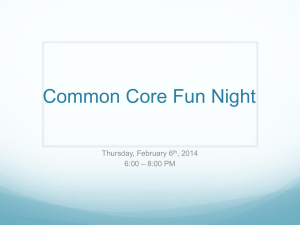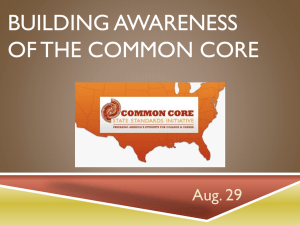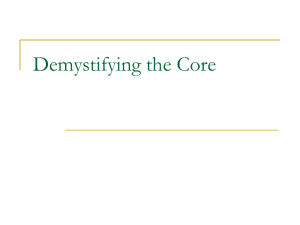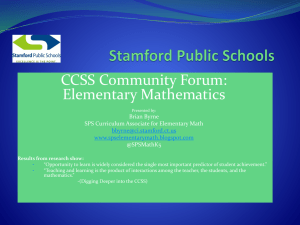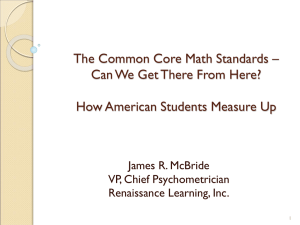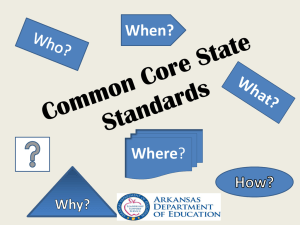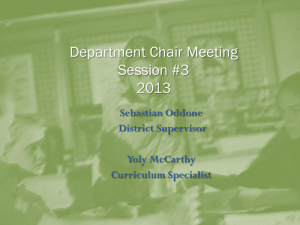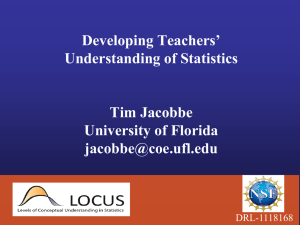The Common Core State Standards require teachers to… increase
advertisement
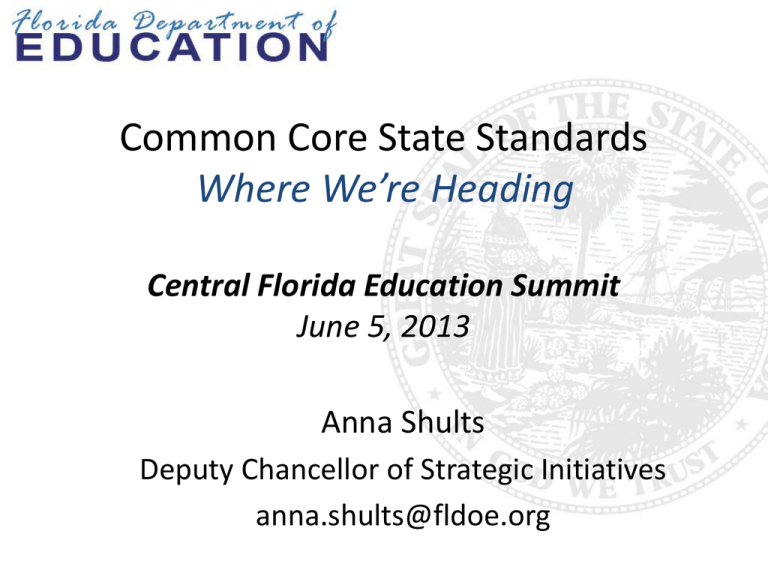
Common Core State Standards Where We’re Heading Central Florida Education Summit June 5, 2013 Anna Shults Deputy Chancellor of Strategic Initiatives anna.shults@fldoe.org Common Core State Standards (CCSS) An overview… Who? • The CCSS were developed and voluntarily adopted by forty-five states, including the District of Columbia, four territories and the Department of Defense. What? • The CCSS are academic standards that define what students need to learn for English/Language Arts (K-12), Mathematics (K-12), and Literacy in History/Social Studies, Science and Technical Subjects (6-12). When? • In 2010, Florida’s State Board of Education adopted a new set of academic standards called the Common Core State Standards. These standards will be fully implemented across K-12 classrooms in the 2014-15 school year. Why? • These new standards enhance the rigor and depth of information that students must learn in school, and focus on preparing students with the essential knowledge and skills needed to be successful in college and careers. 2 Changes in Student Expectations The Common Core State Standards & assessment demand students… • maintain an increased sense of accountability toward their own learning • develop a concept beyond an opinion and move to “support and evidence” • think in a more conceptual, analytical and global manner • utilize higher-order, critical thinking skills • shift from mere memorization of terms to a deep understanding of meaning • transfer skills to new experiences • operate in a more student-centered environment with built in peer collaboration 3 Changes to Instruction The Common Core State Standards require teachers to… • increase rigor • serve as facilitators of learning for all students • provide guided practice, followed by the necessary support, as students take on more independence with tasks • share the ownership for text understanding in all content areas • find new ways of teaching critical thinking skills 4 The Common Core State Standards represent an informed consensus on how best to prepare this country’s young people for college and careers. The standards describe “the what” that students need to learn; however, they do not spell out “the how” for teachers. 5 A Closer Look MATHEMATICS ENGLISH LANGUAGE ARTS/LITERACY Focus: Focus strongly where the standards focus Building knowledge through content-rich nonfiction Coherence: Think across grades, and link to major topics Reading, writing, and speaking grounded in evidence from text, both literary and informational Rigor: In major topics, pursue conceptual understanding, procedural skill and fluency, and application Regular practice with complex text and its academic language NEW: Standards for Mathematical Practice NEW: Literacy standards for history, science and technical subjects ANCHORED IN COLLEGE AND CAREER READINESS So, what do the CCSS really look like? Third Grade Writing Standard Common Core With guidance and support from adults, use technology to produce and publish writing (using keyboard skills) as well as to interact and collaborate with others. Current The student will write a final product for the intended audience. 7 So, what do the CCSS really look like? Seventh Grade Reading Standard Common Core Trace and evaluate the argument and specific claims in a text, assessing whether the reasoning is sound and the evidence is relevant and sufficient to support the claims. Current The student uses a variety of strategies to comprehend grade level text. 8 Florida’s CCSS Implementation Plan Phase 1 (2011-2012) Full Implementation Grade K Phase 2 (2012-2013) Full Implementation Grades Phase 3 (2013-2014) Begin Implementation of K-1 Literacy Standards in ALL Content Areas for Grades 6Full Implementation Grades Phase 4 (2014-2015) 12 Begin Implementation of Rich and Complex Text and Informational Text for Grades K-12 Full Implementation of Literacy Standards in ALL Content Areas for Grades 612 K-2 Full Implementation Grades K-12 Implementation of a Blended Curriculum (CCSS and Supplemental NGSSS PARCC Assessments Aligned Continue Implementation of Aligned to FCAT 2.0 and to CCSS Rich and Complex Text and EOCs) for Grades 3-12 Informational Text for Grades K-12 Continue Implementation of Rich and Complex Text and Informational Text for Grades K-12 9 CCSS Assessment The assessment is designed to reward quality instruction aligned to the Standards, so the assessment is worthy of preparation rather than a distraction from good work. • Texts Worth Reading: The assessments will use authentic texts worthy of study instead of artificially produced or commissioned passages. • Questions Worth Answering: Sequences of questions that draw students into deeper encounters with texts will be the norm (as in an excellent classroom), rather than sets of random questions of varying quality. • Better Standards Demand Better Questions: Instead of reusing existing items, PARCC will develop custom items to the Standards. • Fidelity to the Standards (now in Teachers’ hands): PARCC evidences are rooted in the language of the Standards so that expectations remain the same in both instructional and assessment settings. 10 Sample Question: 4th Grade Math FCAT Sample Question: 4th Grade Math PARCC Common Core Resources CPALMS is Florida’s Next Generation Sunshine State Standards and Common Core database • http://www.floridastandards.org Common Core State Standards for Mathematics and English Language Arts and Literacy in History/Social Studies, Science and Technical Subjects • http://www.corestandards.org/ COMING SOON • NEW Common Core website • Parent Resources • Teacher Toolkits 13

